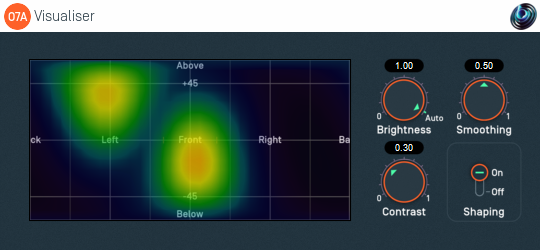O7A Visualiser

Host Support
| Host Type | Support |
|---|---|
| AAX | Yes |
| VST2 | Yes |
Audio
| Channels | Content | |
|---|---|---|
| Input | 64 | O7A |
| Output | 64 | O7A |
Controls
Description
This plugin produces a view of an O7A stream which can help make sense of what is happening in it. Audio is passed through unmodified, so the plugin can be inserted in the middle of an O7A effects chain.
The stream is shown using a rectangular screen region. This rectangular region shows an equal-area cylindrical projection of the directional components of the O7A soundfield interpreted over a sphere.
Or, to put it another way, it lights up in different places depending on where a sound comes from. Some of those places are labelled in the image. The view is like a map of the world, where sounds above are at the "north pole" and are shown across the top of the view and sounds below are at the "south pole" at the bottom. Sounds rotating around at head height move around the equator, so they move along the view halfway down, wrapping around between the left and right edges as they pass behind.
A good way to try this out is to chain the O7A Panner immediately before this plugin as this uses the same directional approach. Then set up a decoder after this suitable for use with your speakers or headphones. Then you can play around with different sound directions and hear and see the results.
To reduce CPU load, this visualiser stops most processing when it is not on screen.
This plugin does not have O7A View support. You might wish to consider O7A Flare.
The plugin is available in the O7A Core plugin library.
Controls
Control: Brightness
This controls the brightness of the image. If the screen is black when sounds are playing, you may wish to turn this up. If it is all red, turn it down.
Alternatively, you can set the dial to "Auto", in which case the plugin will try to ride the brightness control to keep the visualisation useful.
Control: Contrast
This controls the contrast of the image. Higher values produce a sharper image but map a smaller dynamic range onto the screen.
Control: Smoothing
The image generated is smoothed over time. Use more smoothing for a more stable, slower moving image. Use less for a more responsive one.
Control: Shaping
Shaping should normally be left on as it produces a more straightforward view. If this is turned off, the image will typically be sharper, but ripples will be visible in directions away from original sound directions.
- O7A Beamer
- O7A Colourizer
- O7A Decoder - 5.1 Basic
- O7A Decoder - FuMa
- O7A Decoder - Mono
- O7A Decoder - O1A
- O7A Decoder - O2A
- O7A Decoder - O3A
- O7A Decoder - Stereo
- O7A Flare
- O7A Gain
- O7A Injector - FuMa
- O7A Injector - O1A
- O7A Injector - O2A
- O7A Injector - O3A
- O7A Look
- O7A Meter
- O7A Meter - Signal
- O7A Panner
- O7A Panner - Classic
- O7A Panner - Eight Channel
- O7A Panner - Hemisphere
- O7A Panner - Large
- O7A Panner - Two Channel
- O7A Rotation
- O7A Spatial Delay
- O7A Virtual Microphone
- O7A Visualiser
- O7A Visualiser - Hemisphere
